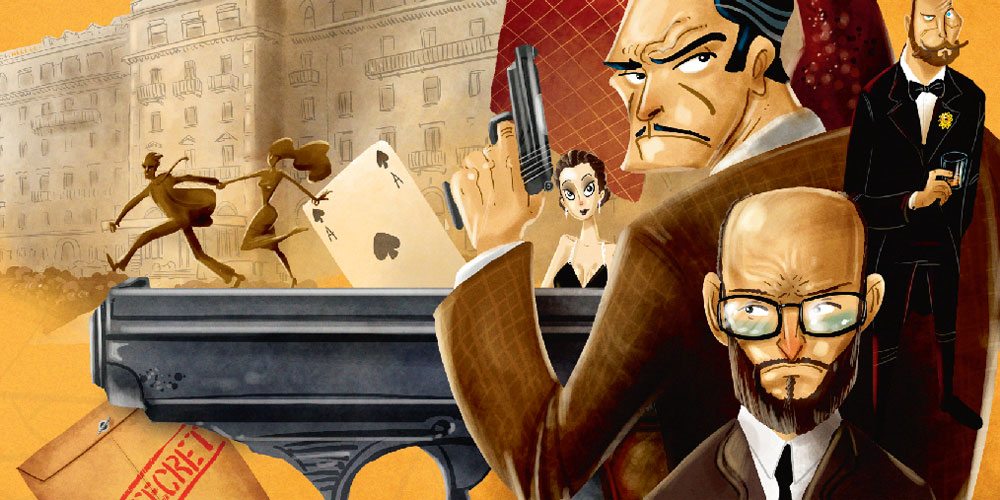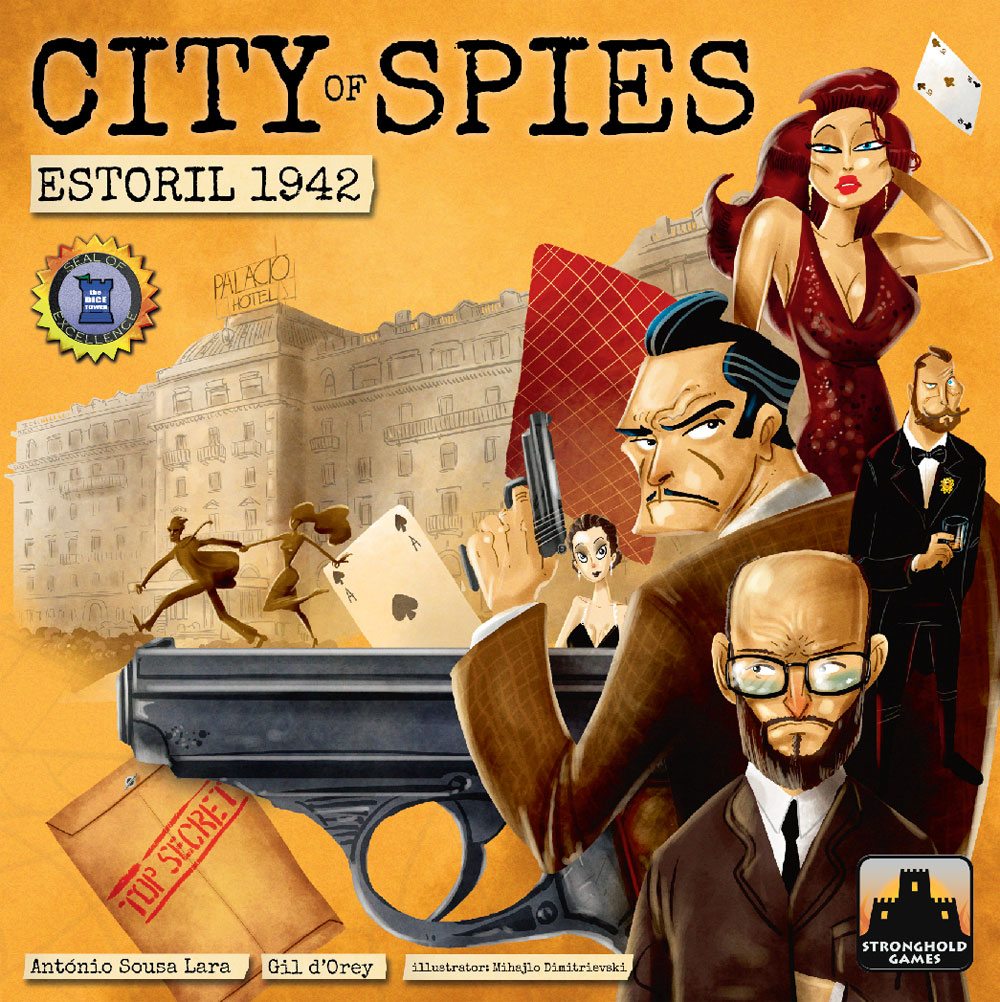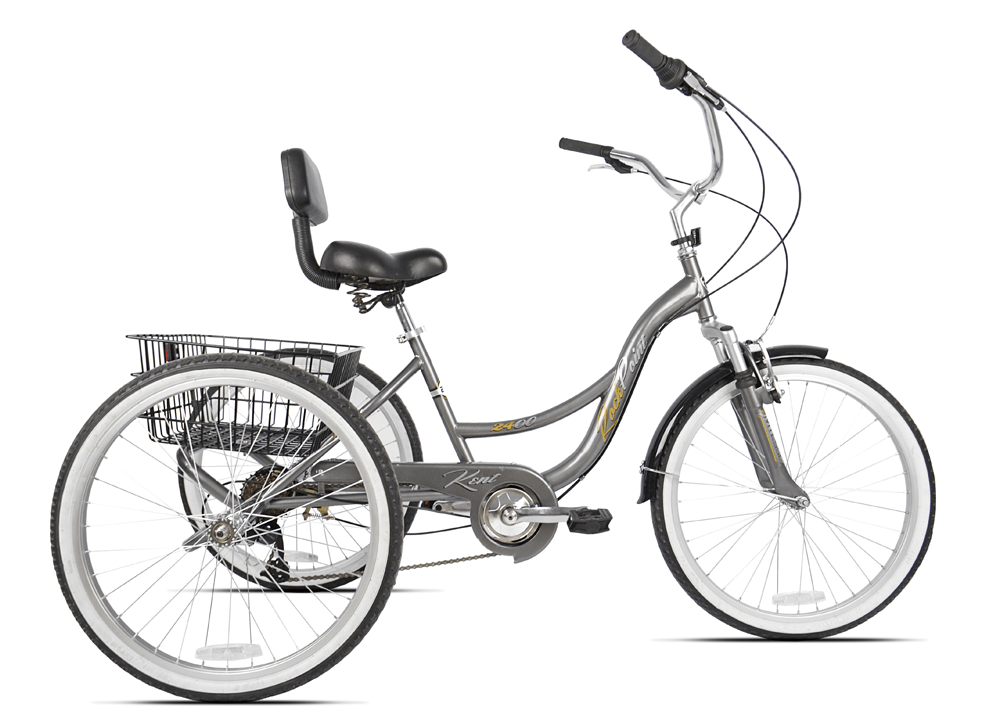Estoril, Portugal, is known for its beach, lovely weather, and casino. And during World War II, it was a hotbed of espionage. Welcome to the City of Spies.
At a glance: City of Spies is a game designed by Gil d’Orey and Antonio Sousa Lara for 2 to 4 players, ages 10 and up, and takes about 45–60 minutes to play. It retails for $49.95 and is available in stores and online. The game is about using hidden information to win battles to recruit new spies, and is a combination of area control, bluffing, and set collection.
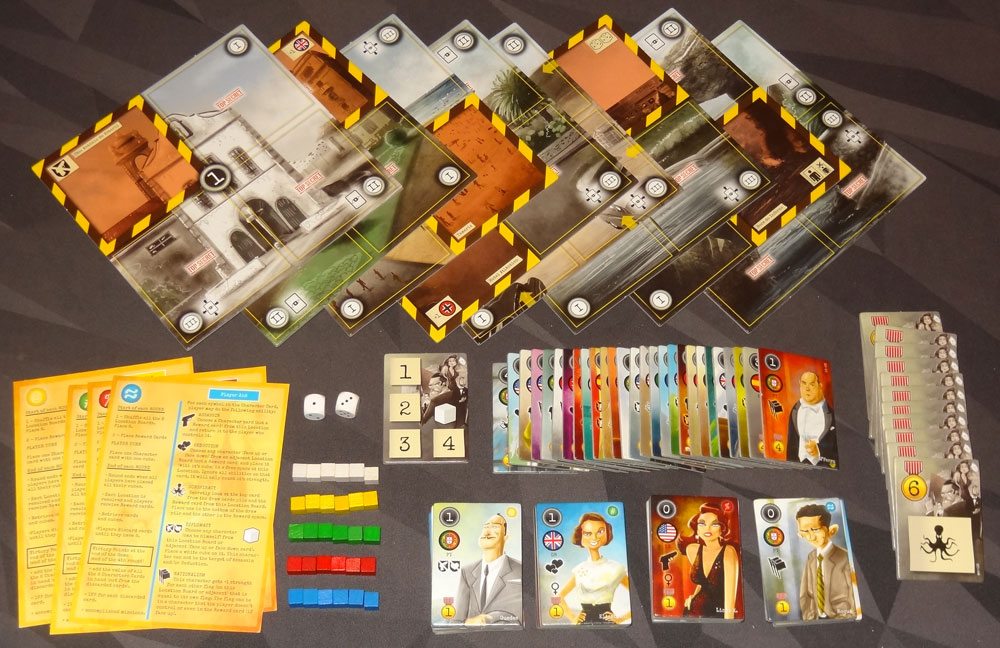
Components
- 30 Cubes (6 each in yellow, blue, green, red, and white)
- 2 Dice
- 12 Mission tiles
- 27 Character tiles
- 24 Starting Character tiles (6 each for 4 players)
- 8 Location boards
- 1st Player tile
- 4 Player Aid cards
All of the tiles are sturdy cardboard punch-outs, so although they function much like cards, they’re thicker and more durable and substantial. The dice are small wooden dice—nothing fancy—and the wooden cubes are standard.
The location boards have artwork in the background representing the location, and various icons indicating things like the order the boards will be resolved in, special properties of each board, and special peek abilities for certain locations. There’s not much text on the boards other than the names of the locations and the “Top Secret” stamp used to indicate that tiles are played face-down, so you’ll have to look up the rules for each location the first time you play. However, once you’ve learned the game, the icons are generally enough.
There’s only one board that’s easy to forget the special rules: the beach. At the beach, all tiles are played face-up, but the way it’s indicated is that there aren’t “Top Secret” stamps on the locations. However, the absence of an icon doesn’t work as well as a reminder—I think it would have been nice to have some additional icon there.

The character tiles are fun, with various portraits of spies from different countries. There are some real people included, like Hedy Lamar, Ian Fleming, and Zsa Zsa Gabor (who, as far as I know, was not actually a spy in real life), but most are not figures I recognize and may or may not be based on actual historical figures. Each tile has various icons showing the spy’s power, nationality, special abilities, and point value. The women are also marked with the “female” symbol but the men aren’t marked with the “male” symbol—I suppose that’s because there’s a mission that awards points for female spies, but it does seem a bit imbalanced to mark one and not the other.
The player aid cards are handy for explaining the turn order and the character abilities, but they do not explain the location special rules or the “peek” abilities on the location boards. The box size is a bit large for the contents—it could fit easily in a Carcassonne-size box (once the components are punched out).
How to Play
The rulebook is available as a PDF from BoardGameGeek.
The object of the game is to build the most valuable team of spies by the end of four rounds—each spy has a point value, but there are also missions in play that will award points to the players whose teams match the mission.
To set up, give each player the 6 starting tiles, player aid, and cubes of their chosen color. (White cubes are used for the diplomacy ability and are not a player color.) The number of cubes you receive depends on the number of players—the more players, the fewer cubes each player gets.
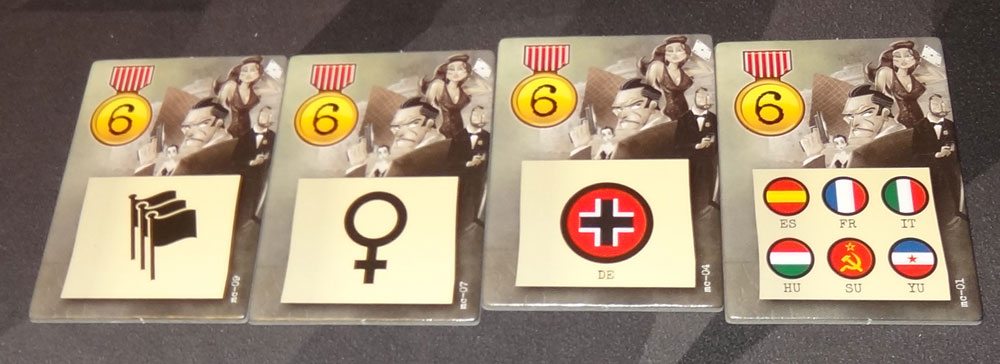
Shuffle the mission tiles and place four mission tiles face-up: these are the missions available for this game. Give the starting player tile to the randomly chosen starting player, and use a white cube to track the round on the tile.
For each round, you will shuffle the 8 location boards and choose 6 at random: these are placed in a 2 × 3 grid, with the location boards oriented randomly so they aren’t all facing the same direction each time. Shuffle the character tiles and place one tile in each of the “reward” spaces (marked with the yellow and black border)—if the space says “Top Secret,” the tile is placed face-down. Now the round is ready to begin.
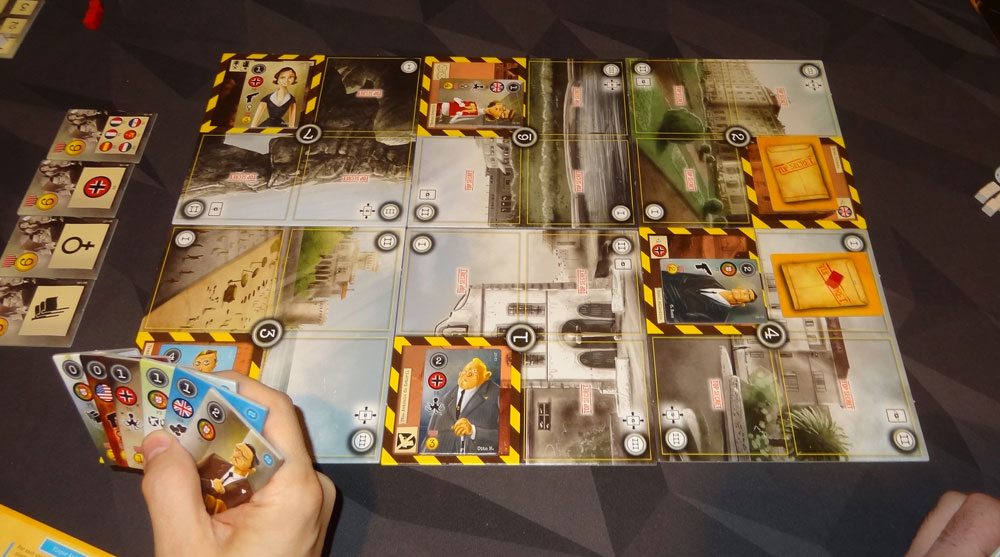
Starting with the first player, each player will place one of their character tiles onto an empty location space, marking it with a cube, until everyone has used up all of their cubes. In general, you must place tiles on the outer edge of the entire play area—to get to an interior space you must have a contiguous path of your tiles from an outer space to the inner space.
Some of the spaces have small icons showing a tile with an eye on it—these allow you to peek at face-down tiles as soon as you place yours there. Some let you peek at a tile only on the same location board, some let you peek at the same or adjacent location board, and some let you peek at a tile anywhere on the play area.
Once everyone has used all of their cubes, the locations are resolved in numerical order.
Turn over all of the character tiles (including the reward) on the location board being resolved. The spaces on the board are then resolved in numerical order—players may activate the abilities on their characters (more on that in a bit). Once all abilities have been resolved, you add up the total strength each player has at the location—the highest strength wins and that player takes the reward tile. If there’s a tie for highest strength, the tied player in the lowest numbered space wins.
Once all of the location boards have been resolved, any remaining reward tiles are discarded to the bottom of the character tiles stack, and everyone retrieves their spies (marked with their cubes). Then, everyone must discard back down to a hand of 6 spies. You keep your own discard pile, because discarded spies are worth 1 point each. Discarded spies are revealed simultaneously.
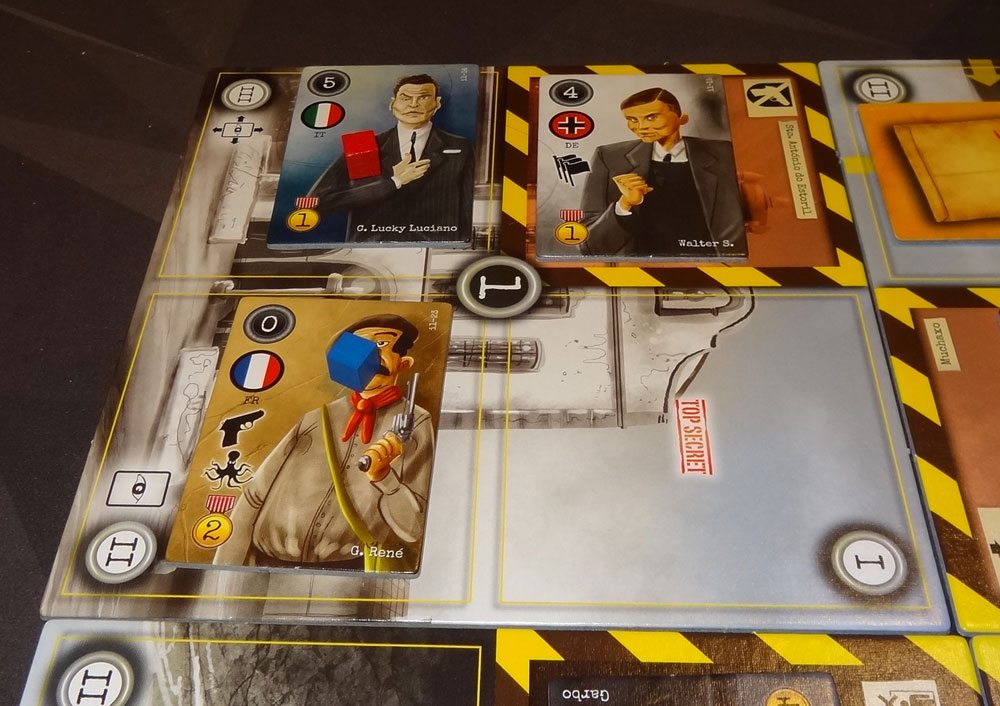
The starting player passes clockwise, and then the next round is set up with new locations and rewards. After four rounds, the game ends and you calculate scores.
Each character you’ve discarded is worth 1 point (regardless of the character’s point value). Each character left in your hand is worth the VP value shown at the bottom left corner. Finally, evaluate each mission. The player who has the most of the required symbols in hand gets the mission tile, which is worth 6 points. If there are ties, the tied players divide the points equally (round down). The highest total score wins—in case of a tie, the player who accomplished the most missions wins.
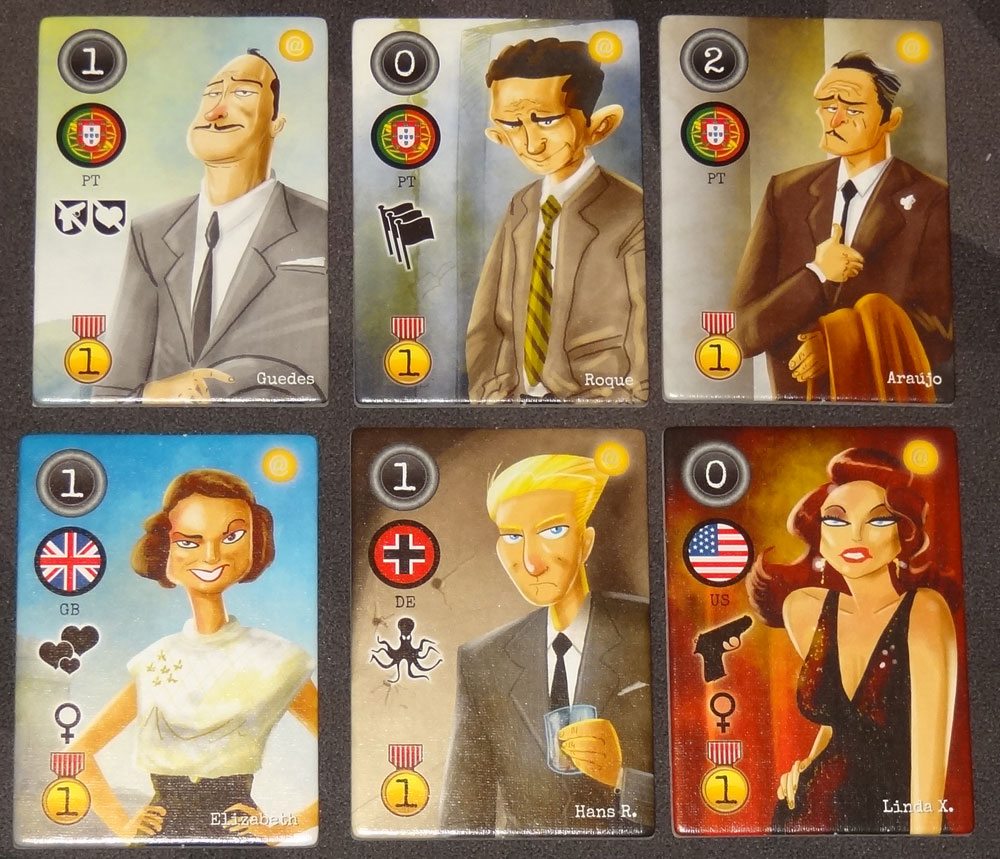
Character Abilities
Most characters have some icons indicating special abilities, though some do not. Character abilities are activated when the location board is resolved.
- Assassin: choose a player’s character tile on this location and return it to the player’s hand.
- Conspiracy: Secretly look at the top tile of the character draw pile and the current reward tile. Place one at the bottom of the draw pile and the other in the reward space.
- Nationalism: This character gets +1 strength for every other face-up matching flag on this location board and adjacent location boards, including flags on tiles belonging to other players or reward tiles.
- Seduction: Choose any player’s character (face-up or face-down) from an adjacent location board and move it to a free space at this location. Ignore the seduced character’s ability; it only counts its strength for its owner on this location.
- Diplomacy: Choose any character on this location or an adjacent location and place a white cube on it. That character cannot be assassinated or seduced.
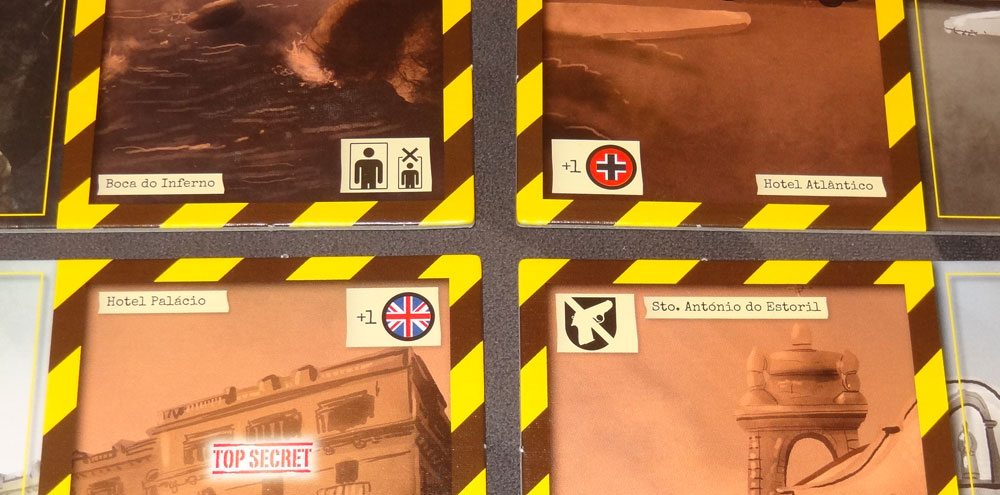
Location Effects
Each of the locations also has a special rule associated with it, and is usually marked somehow on the location board. The numbers also indicate the order that the location boards will be resolved.
- Church: Assassin abilities may not be triggered.
- Hotel Palácio: British characters get +1 strength.
- Tamariz Beach: All tiles (player tiles and reward tiles) are played face up.
- Hotel Atlântico: German characters get +1 strength.
- Muchaxo: All spaces are considered outer spaces for placement purposes.
- Casino: After resolving abilities on this tile, players roll 2 dice for each character tile they control here—the difference between the two dice is added to the strength.
- Hellsmouth Rock: After resolving abilities, if there are at least two players with characters here, the player with the lowest strength must choose a character here to remove from the game. (This is not discarded into your discard pile for 1 point, but is totally out of the game.)
- Museum Conde Castro Guimarães: This location has an extra space on it: 4 spaces in addition to the reward space, rather than 3.
The Verdict
City of Spies combines some familiar mechanics (set collection, area control, hidden information) in a new way, and it makes for a pretty cool game of trying to out-think your opponents.
The area control seems fairly straightforward at first: place your tiles, compare strengths, and see who’s the highest—and even the location board effects don’t complicate that too much. However, the exact placement is important: usually, the higher-numbered deployment spaces (which will activate later, and won’t win ties) have better abilities for peeking at other tiles. So you may have to choose between getting first crack at an ability and being able to check what your opponent has played. Also, if you are trying to work your way into an inner space, that may limit where you can place, depending on the current orientation of the location boards. It’s possible to shut players out of the interior, but often at the cost of placing more of your own spies on fewer location boards.
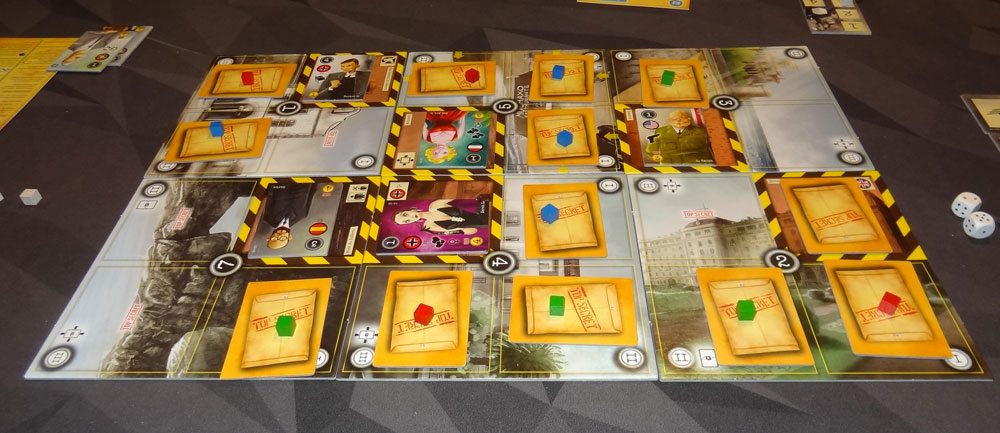
It’s also important to pay attention to the order that the location boards will be resolved, particularly for abilities like diplomacy, nationalism, and seduction, all of which can affect or be affected by adjacent location boards. Diplomacy lets you protect a character from seduction or assassination, so generally you want to trigger that ability as soon as possible—sometimes protecting a character on a location board that will be resolved later, if you happen to know there are assassins or seducers around. Nationalism will get bonus strength from adjacent locations—but only from face-up tiles, so you generally want to place those on boards that will be resolve later. Seduction is a tricky one—maybe you bring over one of your own tiles from an already resolved location to help you win the current round. Or maybe you just take the current loss, but pull over one of your opponent’s tiles from a later board, giving you a better chance at winning that one.
The conspiracy ability useful whether you’re winning or losing, because you’ll get a chance to replace the reward tile. Of course, if you’re trying to foil your opponent’s plan, you have to figure that plan out first before you know which reward tile to give them. Since the discard piles are face-up, you’ll know what your opponents have already gotten rid of, but it’s easy to forget what they’ve picked up.
The ultimate goal of the game is to score the most points, but victory doesn’t always go to the players who go after the missions. Sometimes it’s worth hanging onto a 4-point spy even if it doesn’t have any of the symbols required to fulfill a mission. If a reward shows up that fits more than one mission, it will probably be highly contested—and you may be better off picking up a couple less-desired rewards instead, particularly if you can do it without any competition. After all, every character you collect means you discard a tile, and that’s worth 1 point no matter what.
The game does feel slightly different depending on the number of players. With two players, you’ll each be playing 6 spies. That makes the tile-peeking effects a little more useful, because after looking at your opponent’s tile (or a face-down reward) you may still have enough turns left to do something about it. In a 4-player game, you’ll only get to play 3 spies each, and it can feel a bit more chaotic, since so much can happen between one turn and the next. Even so, there are opportunities for some sneaky moves that can pay off later.
Overall, City of Spies is a clever game that does a good job with the theme: some diplomacy, some assassination, and trying to keep your enemies in the dark about your own plans. It’s a medium-weight game and usually plays fairly quickly once everyone understands the flow of the game. Go ahead: take a trip to Estoril 1942, and see how well you fare!
Disclosure: GeekDad received a review copy of this game.
